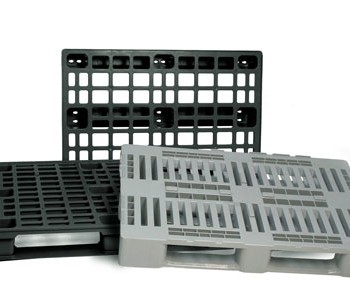Testing the quality of plastic pallets
05 May 2014

All pallet designs have to be tested by a competent authority to ensure that they conform to European and ISO standards that define their load capacities, hygiene and durability.
Many pallet customers will often demand a certificate that provides evidence of tests and their results. Food and pharmaceutical manufacturers need to have confidence in the pallet manufacturer and the product range.
Load Testing
The safe working load of any article used for lifting is the load it can carry without breaking. Pallets can have a number of safe working loads, depending on the types of goods being loaded, if there are any interlocking cartons within the load and other support mechanisms. Britain in particular has a large number of pallet designs that do not have a common safe working load.
The pallet can be tested in two ways: a proof test to determine its load capacity for specific circumstances and load, and a destruction test that loads the pallet well beyond its safe working load and to destruction.
Initially, the pallet itself does not need to be tested. At the design stage, a computational model of the pallet can be refined according to its test responses. If necessary, a scaled-down physical model can be used for the secondary tests. However, as pallets are not major structures such as buildings, it is best to test the final product directly.
Hygiene
Food and pharmaceutical manufacturers acknowledge that plastic pallets are by far the most hygienic as well as most cost-effective method for moving goods. Hygiene tests on wooden pallets in Europe and North America have shown that they could house harmful pathogens. All surfaces on a plastic pallet need to be smooth and sealed so that they cannot be contaminated by bacteria, mould and dust.
High-quality virgin or recycled polymers, such as high-density polyethylene, used in pallets need to be tolerant of some weaker acids, alkalis and other chemicals. The test has to ensure that there are no loose parts of the pallet or other components of any ancillary lifting device or trolley that could break off and cause accidents and injuries.
Durability
The lifespan of an average plastic pallet can be up to five years, as long as it is manufactured according to international standards. The pallet should be able to withstand all the rigours of warehousing and transportation. Tests to examine the durability of the pallet are in these basic types:
A random vibration test that is essentially a computer simulation of the stresses a pallet should withstand during goods transport.
A compression and bending test that helps to estimate the pallet’s strength and stiffness under load. These tests should include a creep analysis to see how the pallet reacts over time to different pressures and temperatures, especially in harsh environments.
A drop test where the pallet free-falls about a metre to the ground. This examines how the corners and edges react to impact. Vacuum or reduced pressure test to examine how the pallets withstand low pressures during air freight or high altitudes.
